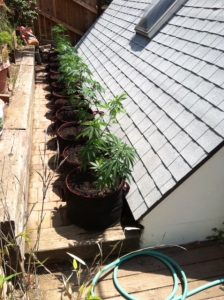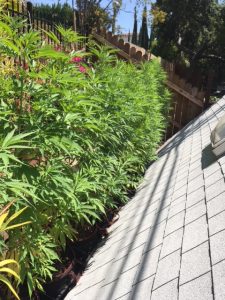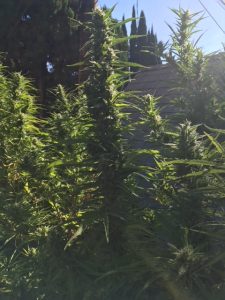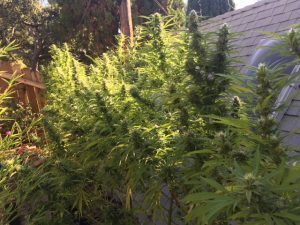
I have a friend who grows his own marijuana. He lives in an old but well-kept house nestled in the hills of a large American city. He grows his marijuana on a fenced-in corridor behind an A-frame studio. Trees border the hillside keeping the sun off the slope until mid-morning. As the afternoon progresses, the sun follows an arc perpendicular to the single row of weed seedlings before it disappears over the studio’s roof line. The location is banal, typical of backyards in a neighborhood that is civilized but not extravagant. The landscape seems Mediterranean with its white stucco buildings and terracotta roofs, all surrounded by palm and cypress trees, blazing bougainvillea and the ubiquitous ficus.
Season after season, he perfects his crop amidst civilization's sturm und drang.
My friend calls his garden the Ho Chi Minh trail because, like its Vietnamese prototype, the marijuana and its camouflage— bamboo and bougainvillea — is potted and portable. The plants are constantly in flux as they grow taller and require protection from different angles and positions. Over weeks and months, the marijuana and its potted floral camouflage dance in stop action, courtly, facing, circling, and bowing to one another.
 My friend has never been discovered, even after decades of guests, gardeners, and meter readers, the plants maturing from yellow to dark green beneath the thudding blades of cop ‘copters. “I keep the place mundane,” my friend told me. “So as not to attract attention.”
My friend has never been discovered, even after decades of guests, gardeners, and meter readers, the plants maturing from yellow to dark green beneath the thudding blades of cop ‘copters. “I keep the place mundane,” my friend told me. “So as not to attract attention.”
In contrast to its mundane surroundings — the middle-class homes, the winding streets, the city spread around him — my friend’s marijuana yields a bounty of exotic, and powerful buds. Grown from carefully pedigreed seeds, marijuana strains pass on an ancient dichotomy between indica and sativa. Eighteenth-century botanists first noticed this indica v sativa dyad when hemp competed with cotton as an alternate material good for fabricating rope, ship sails, paper, and clothing.
Indica strains probably developed in the Himalayan ecosystems of Afghanistan. They produce sticky, powerful resins as a protection against a high-altitude climate. Indicas elicit dreamy, mellowing effects from their passengers. When you smoke an indica strain you feel “stoned” in the classic sense, a few beats behind the action, your whole body feeling happy, hungry, or sleepy. As a medicine, indicas can stimulate hunger and nurse away anxiety, insomnia, muscle pain, and more.
Sativas differ from indicas because they developed in opposite environments, the equatorial forests of South America and Southeast Asia for example. Sativas are more cerebral. They can turn you on, speed you up, give you bursts of energy. You might want to talk or go somewhere to trip on reality, like out in the world. Sativas make good medicine to deal with depression, attention-deficit disorder, and fatigue. My friend knows them all and could describe them in greater detail than I.
 My friend’s farming methodology has changed over the 20-plus years he has cultivated his hillside garden. He began by keeping seeds from a great batch of Humboldt weed that his friends grew above a river that ran into the Pacific on a black-sand beach below. In the spring, at the equinox, he let the seeds sprout in a womb of water for two days, then carefully lowered the fragile plants into gardening soil. The yield was low, but by July, he already had a row of exuberant plants growing in the sun behind his studio. He had already found his spot.
My friend’s farming methodology has changed over the 20-plus years he has cultivated his hillside garden. He began by keeping seeds from a great batch of Humboldt weed that his friends grew above a river that ran into the Pacific on a black-sand beach below. In the spring, at the equinox, he let the seeds sprout in a womb of water for two days, then carefully lowered the fragile plants into gardening soil. The yield was low, but by July, he already had a row of exuberant plants growing in the sun behind his studio. He had already found his spot.
He learned how to sex the plants. Males were immediately murdered without mercy. The boys produced pathetically low cannabis content and no buds; their leaves would give you a sore throat before they got you high. And the exuberant young males spread their pollen everywhere, impregnating their female companions and thereby distracting them from blooming.
“It’s harsh,” my friend told me. “But by killing the males, we push the females to blossom into fragrant buds imbued with their own ecstasy. Which would you choose? Generating resinous glory or producing seeds for the next cannabis generation? Regardless, if the males were to survive, they would burden the remaining females with reproductive responsibility. Sexual harassment lurks even in botanical realms.”
In the beginning, my friend closely guards the seedling shoots. Within two days, the sprouts poke through the dark soil to greet the sun. After hibernating in a tiny peat cup filled with warm potting soil, each root triumphantly thrusts the two halves of its seed shells aloft until the now-vestigial seed wombs dry up and blow away. After a week, my friend would fill 12 or 15 five-gallon plastic pots with soil, a rich blend of composted humus, peat moss, Pacific fish emulsion, crab meal, shrimp meal, worm castings, sandy loam, perlite, bat guano, granite dust, kelp, and oyster shell (for pH adjustment). Recently, he graduated to sturdy cloth baskets, each holding 25 gallons of special soil. Now, he waters his ‘babies’ with a tea he steeps in a bright blue plastic container with an air pump that bubbles oxygen into the brew.
 Four weeks after planting, he admires the beautiful yellow-green cannabi reaching upward toward the sun in a universe of rich dark loam. He also learned to put no more than three plants in each planter bucket. Yes, there is often attrition and the boys will be murdered but — according to my friend, “weed behaves according to the fundamentals of botany. Space serves as a constant; the plants will consume whatever air, light, and water available in a given space. A single, mature plant can yield more than three plants occupying the same space.”
Four weeks after planting, he admires the beautiful yellow-green cannabi reaching upward toward the sun in a universe of rich dark loam. He also learned to put no more than three plants in each planter bucket. Yes, there is often attrition and the boys will be murdered but — according to my friend, “weed behaves according to the fundamentals of botany. Space serves as a constant; the plants will consume whatever air, light, and water available in a given space. A single, mature plant can yield more than three plants occupying the same space.”
And so it goes; the great green beauties grow to form their own Ho Chi Minh canopy of foliage. The grasshoppers who first appeared as diaphanous, light-green babies grow and harden, their legs and bodies turn dark green, then brown. Of course they stay. They live their whole lives fat, protected, and stoned. Harvesting begins with a few outrigger blossoms. After an afternoon of drying in the sun, these buds can be smoked. With the resin forming crystals on the myriad of tiny leaves, this early pot can be mind-numbingly powerful, a promise of highs to come. The rest of the crop comes down plant by plant. By the time of harvest, my friend has manicured the plants, immaculately stripping away vestigial leaves, atrophied buds, manicuring the buds on branches while they’re still in the ground. When cut, the branches a sequestered in a dark garage with a humidifier and gauges to ensure their potency.
 Today, we all celebrate. January 1, 2018 signaled the end of weed paranoia for generations of pot heads. And my friend? Season after season, he perfects his crop amidst civilization’s sturm und drang.
Today, we all celebrate. January 1, 2018 signaled the end of weed paranoia for generations of pot heads. And my friend? Season after season, he perfects his crop amidst civilization’s sturm und drang.
Writer, editor, and educator based in Los Angeles. He's also played a lot of music. Degelman teaches writing at California State University, Los Angeles.
Degelman lives in the hills of Hollywood with his companion on the road of life, four cats, assorted dogs, and a coterie of communard brothers and sisters.



Lovely and lyrical, almost poetic. With all your friend’s care and nurture, I can only imagine how sweet the effect must be. You are fortunate to know him.
Yes, I am one lucky man. Altho weed has never been a major focus in my life, even back in THOSE times, I am fortunate to have this person in my life; as I wrote this short piece, I realize how much knowledge and wonder I carry with me, thanks to my friend.
Beautifully told story about a true craftsman, Charles. Oh, to live the life of those grasshoppers!
I’m glad you enjoyed this two-line character profile of marijuana and my friend. I’m discovering there’s more to say. For example, it would be fun to trace the development of a crop through the many, many eyes of those grasshoppers in paradise!
“Sexual harassment lurks even in botanical realms”. Wonderful allusion; fascinating story. That your friend has gotten away with his harvest for 20 years is amazing. And you describe the learning curve and each strain of the herb with great detail. Let’s hope this business continues to grow and flourish.
Ha! Yes, for being a recluse, my friend’s allusion to the ubiquitous nature of sexual harassment certainly applies today. It has been fun to watch and occasionally help out as his knowledge, skills, and experience continue to grow. Actually, my friend doesn’t sell his provender. He and his family consume much and he gifts to people who need it for medicinal purposes and just to get loaded. And he trades some for various artisans throughout the community.
Wonderful story, Charlie. Well-written, of course, and full of so much useful information that I feel like I just took a course called Marijuana 101. And your friend certainly sounds like a fascinating character.
thanks, Suzy! I’m glad you enjoyed taking Marijuana 101! The more I wrote on the topic, the more I realized I knew about my friend’s body of knowledge. Growing weed in the age of genetics and biochemistry is a complex and sophisticated field, a world unto itself.